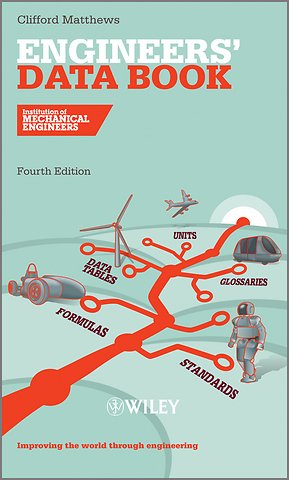IMechE Engineers′ Data Book 4e
Samenvatting
A completely revised and expanded fourth edition of this best–selling pocket guide. Engineers′ Data Book provides a concise and useful source of up–to–date essential information for the student or practising engineer.
Updated, expanded edition
Easy to use
Handy reference guide
Core technical data
Specificaties
Inhoudsopgave
<p>Preface xiii</p>
<p>Introduction The Role of Technical Standards xv</p>
<p>Section 1: Engineering Careers 1</p>
<p>1.1 Introduction: what is an engineer? 1</p>
<p>1.2 A rough guide to industry breakdown 3</p>
<p>1.3 Training and professional development 4</p>
<p>1.4 Degrees of (engineering) excellence 5</p>
<p>1.5 Degrees and how to pass them 9</p>
<p>1.6 Do you have any . . . experience? 12</p>
<p>1.7 Final cut job interviews 14</p>
<p>Section 2: Units 18</p>
<p>2.1 The Greek alphabet 18</p>
<p>2.2 Units systems 19</p>
<p>2.3 Units and conversions 21</p>
<p>2.4 Consistency of units 32</p>
<p>2.5 Dimensional analysis 36</p>
<p>2.6 Essential engineering mathematics 38</p>
<p>2.7 Maths and the real world? 40</p>
<p>Section 3: Engineering Design Process and Principles 49</p>
<p>3.1 Engineering problem–solving 49</p>
<p>3.2 Problem types and methodologies 49</p>
<p>3.3 Design principles 51</p>
<p>3.4 The engineering design process 52</p>
<p>3.5 Design as a systematic activity (the ′pugh′ method) 53</p>
<p>3.6 The innovation model 53</p>
<p>3.7 Creativity tools 57</p>
<p>3.8 The product design specification (PDS) 58</p>
<p>3.9 Presenting technical information 60</p>
<p>3.10 The anatomy of mechanical design 79</p>
<p>3.11 Safety in design principles and practice 89</p>
<p>3.12 Design by nature project toucan 105</p>
<p>Section 4: Basic Mechanical Design 110</p>
<p>4.1 Engineering abbreviations 110</p>
<p>4.2 Datums and tolerances principles 112</p>
<p>4.3 Toleranced dimensions 113</p>
<p>4.4 General tolerances 114</p>
<p>4.5 Holes 115</p>
<p>4.6 Screw threads 116</p>
<p>4.7 Limits and fits 117</p>
<p>4.8 Surface finish 119</p>
<p>Section 5: Motion 122</p>
<p>5.1 Making sense of equilibrium 122</p>
<p>5.2 Motion equations 123</p>
<p>5.3 Newton′s laws of motion 124</p>
<p>5.4 Simple harmonic motion (SHM) 125</p>
<p>5.5 Understanding acceleration 126</p>
<p>5.6 Dynamic balancing 126</p>
<p>5.7 Vibration 128</p>
<p>5.8 Machine vibration 129</p>
<p>5.9 Machinery noise 130</p>
<p>Section 6: Deformable Body Mechanics 133</p>
<p>6.1 Quick reference mechanical notation 133</p>
<p>6.2 Engineering structures so where are all the pin joints? 135</p>
<p>6.3 Simple stress and strain 136</p>
<p>6.4 Simple elastic bending 138</p>
<p>6.5 Slope and deflection of beams 140</p>
<p>6.6 Torsion 142</p>
<p>6.7 Thin cylinders 145</p>
<p>6.8 Cylindrical vessels with hemispherical ends 146</p>
<p>6.9 Thick cylinders 147</p>
<p>6.10 Buckling of struts 148</p>
<p>6.11 Flat circular plates 149</p>
<p>6.12 Stress concentration factors 151</p>
<p>Section 7: Material Failure 155</p>
<p>7.1 How materials fail 155</p>
<p>7.2 LEFM method 156</p>
<p>7.3 Multi–axis stress states 157</p>
<p>7.4 Fatigue 158</p>
<p>7.5 Factors of safety 161</p>
<p>7.6 United states practice 161</p>
<p>7.7 Ultimate jigsaw what everything is made of 162</p>
<p>Section 8: Thermodynamics and Cycles 166</p>
<p>8.1 Quick reference: symbols thermodynamics 166</p>
<p>8.2 Basic thermodynamic laws 167</p>
<p>8.3 Entropy 169</p>
<p>8.4 Enthalpy 169</p>
<p>8.5 Other definitions 170</p>
<p>8.6 Cycles 170</p>
<p>8.7 The steam cycle 172</p>
<p>8.8 Properties of steam 172</p>
<p>8.9 Reference information 175</p>
<p>8.10 The gas turbine (GT) cycle 175</p>
<p>Section 9: Basic Fluid Mechanics and Aerodynamics 178</p>
<p>9.1 Basic properties 178</p>
<p>9.2 Flow equations 180</p>
<p>9.3 Flow regimes 186</p>
<p>9.4 Boundary layers 189</p>
<p>9.5 Isentropic flow 191</p>
<p>9.6 Compressible one–dimensional flow 191</p>
<p>9.7 Normal shock waves 192</p>
<p>9.8 Axisymmetric flows 195</p>
<p>9.9 Drag coefficients 195</p>
<p>9.10 General airfoil theory 197</p>
<p>9.11 Airfoil coefficients 198</p>
<p>9.12 Pressure distributions 200</p>
<p>9.13 Aerodynamic centre 200</p>
<p>9.14 Centre of pressure 201</p>
<p>9.15 Supersonic conditions 202</p>
<p>9.16 Wing loading: semi–ellipse assumption 204</p>
<p>Section 10: Fluid Equipment 206</p>
<p>10.1 Turbines 206</p>
<p>10.2 Refrigeration systems 207</p>
<p>10.3 Diesel engines 209</p>
<p>10.4 Heat exchangers 210</p>
<p>10.5 Centrifugal pumps 212</p>
<p>10.6 Impeller types 214</p>
<p>Section 11: Pressure Vessels 216</p>
<p>11.1 Vessel codes and standards 216</p>
<p>11.2 Pressure vessel design features 219</p>
<p>11.3 Cylindrical pressure vessel design stresses 220</p>
<p>11.4 Stress categories 221</p>
<p>11.5 Analysis of stress combinations 222</p>
<p>11.6 Vessel certification 223</p>
<p>11.7 Flanges 223</p>
<p>Section 12: Materials 225</p>
<p>12.1 Observing crystals: order and disorder 225</p>
<p>12.2 Carbon steels 226</p>
<p>12.3 Low–alloy steels 227</p>
<p>12.4 Alloy steels 227</p>
<p>12.5 Cast iron (CI) 228</p>
<p>12.6 Stainless steels 230</p>
<p>12.7 Non–ferrous alloys 233</p>
<p>12.8 Nickel alloys 233</p>
<p>12.9 Zinc alloys 234</p>
<p>12.10 Copper alloys 234</p>
<p>12.11 Aluminium alloys 235</p>
<p>12.12 Titanium alloys 236</p>
<p>12.13 Engineering plastics 237</p>
<p>12.14 Material traceability and documentation 238</p>
<p>12.15 Corrosion 239</p>
<p>Section 13: Machine Elements 244</p>
<p>13.1 Screw fasteners 244</p>
<p>13.2 Bearings 247</p>
<p>13.3 Ball and roller bearings 248</p>
<p>13.4 Bearing lifetime 249</p>
<p>13.5 Coefficient of friction 250</p>
<p>13.6 Gear trains 251</p>
<p>13.7 Seals 254</p>
<p>13.8 Shaft couplings 257</p>
<p>13.9 Cam mechanisms 259</p>
<p>13.10 Clutches 261</p>
<p>13.11 Pulley mechanisms 264</p>
<p>13.12 Drive types 266</p>
<p>Section 14: Quality Assurance and Quality Control 267</p>
<p>14.1 Quality assurance: ISO 9001: 2008 267</p>
<p>14.2 Quality system certification 268</p>
<p>14.3 The ISO 9001 standard 269</p>
<p>14.4 Taguchi methods 271</p>
<p>14.5 Statistical process control (SPC) 272</p>
<p>14.6 Normal distribution 272</p>
<p>14.7 The binomial and poisson distributions 274</p>
<p>14.8 Reliability 274</p>
<p>14.9 Improving design reliability: main principles 277</p>
<p>14.10 ′Design for reliability′ a new approach 278</p>
<p>Section 15: Project Engineering 281</p>
<p>15.1 Project planning 281</p>
<p>15.2 Critical path analysis (CPA) 282</p>
<p>15.3 Planning with Gantt charts 283</p>
<p>15.4 Rapid prototyping 284</p>
<p>15.5 Value analysis 285</p>
<p>Section 16: Welding 286</p>
<p>16.1 Welding processes 286</p>
<p>16.2 Weld types and orientation 289</p>
<p>16.3 Welding symbols 292</p>
<p>16.4 Welding defects 295</p>
<p>16.5 Welding documentation 297</p>
<p>Section 17: Non–Destructive Testing (NDT) 299</p>
<p>17.1 Non–destructive testing acronyms 299</p>
<p>17.2 Visual examination 301</p>
<p>17.3 Dye penetrant (DP) testing 301</p>
<p>17.4 Magnetic particle (MP) testing 302</p>
<p>17.5 Ultrasonic testing (UT) 303</p>
<p>17.6 Radiographic testing (RT) 313</p>
<p>Section 18: Surface Protection 318</p>
<p>18.1 Painting 318</p>
<p>18.2 Galvanizing 320</p>
<p>18.3 Chrome plating 320</p>
<p>18.4 Rubber linings 321</p>
<p>Section 19: Metallurgical Terms 324</p>

